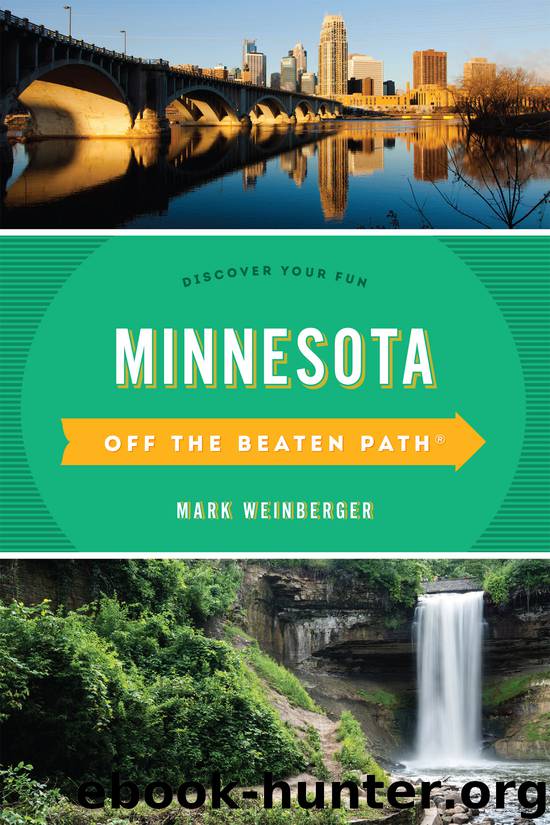Minnesota Off the Beaten Path® by Mark R. Weinberger

Author:Mark R. Weinberger
Language: eng
Format: epub
ISBN: 9781493031214
Publisher: Globe Pequot Press
Published: 2017-12-12T05:00:00+00:00
Cottonwood County
This southwestern Minnesota county received its name because the Cottonwood River touches the northeast corner of the county. The Sioux Indians called the river Waraju for the dense stands of cottonwoods that grew on the banks. Sparsely populated, the county remained so until after the Civil War and the end of the bloody Dakota uprising of 1862. Windom, the largest town in the county, has two buildings of historic significance. The courthouse is on the National Register of Historic Places, and the power plant is the first municipal building in the United States to be listed in the Art Deco Registry.
Heritage Village in Mountain Lake, northeast of Windom, is essentially a pioneer village—a museum built of a variety of transplanted historic buildings construed to represent a typical bygone town—but it’s one with a couple of unusual twists. First, there are an extensive collection of historic telephone equipment and a general store that is stocked much as it was when it went out of business early in the 20th century. Second, the area’s Mennonite traditions are preserved in the Heritage Ayte Shtade (meaning “eating place”) restaurant, located on the village grounds on CR 1, 1 mile south of MN 60.
The inexpensive meals served by costumed staff at the Ayte Shtade reflect the fact that the Mennonites traveled widely throughout Europe in their search for social environments tolerant of their religious beliefs. Such Mennonite dishes as moos, a delicious cold fruit soup; klups, a meat loaf patty with vegetables; and perischki, dumplings with fruit, reflect ethnic influences from much of northern Europe. The restaurant is open summer evenings (it’s closed in winter) Thurs through Sat and at noon on Sun.
Though the experience is guaranteed to bring you rather abruptly back to the present, there are two contemporary private residences in Mountain Lake that are well worth a drive by. Both were designed in the 1970s by architect Bruce Goff. The Glen Harder House is held to the ground by three large, irregularly shaped piles of stones that also serve as chimneys. Each of these is topped by a large sheet-metal cap with swept-up, pointy corners. These anchors are apparently necessary, as the house itself looks as though it’s hovering a few feet off the ground, except at the corners, which are pulled earthward as if held down by spikes. The peaked roof has extended pointy eaves, in the style of the chimney caps, and draws attention to itself from miles around with its bright orange color. To find this creation, go south on CR 1 from MN 60 just over 4 miles to CR 13, turn east and go 2 miles, and then turn south on a gravel road, from which you can see the house.
The Jacob Harder House has been described by one architectural historian as looking like a “pregnant spaceship... sheathed in fish-scale shingles which really look more like chicken feathers.” Looked at another way, this circular dwelling, with its two bug-eyed bay windows separated by a proboscis-like bulge in the wall, just might be the visage of some extraterrestrial insect.
Download
This site does not store any files on its server. We only index and link to content provided by other sites. Please contact the content providers to delete copyright contents if any and email us, we'll remove relevant links or contents immediately.
Giovanni's Room by James Baldwin(6820)
The Plant Paradox by Dr. Steven R. Gundry M.D(2433)
The Stranger in the Woods by Michael Finkel(2330)
Miami by Joan Didion(2166)
Wild: From Lost to Found on the Pacific Crest Trail by Cheryl Strayed(2143)
INTO THE WILD by Jon Krakauer(2087)
Trail Magic by Trevelyan Quest Edwards & Hazel Edwards(2064)
DK Eyewitness Top 10 Travel Guides Orlando by DK(2058)
Vacationland by John Hodgman(2034)
The Twilight Saga Collection by Stephenie Meyer(2029)
Nomadland by Jessica Bruder(1960)
Birds of the Pacific Northwest by Shewey John; Blount Tim;(1876)
The Last Flight by Julie Clark(1837)
Portland: Including the Coast, Mounts Hood and St. Helens, and the Santiam River by Paul Gerald(1820)
On Trails by Robert Moor(1794)
Deep South by Paul Theroux(1718)
Blue Highways by William Least Heat-Moon(1664)
Trees and Shrubs of the Pacific Northwest by Mark Turner(1645)
1,000 Places to See in the United States and Canada Before You Die (1,000 Places to See in the United States & Canada Before You) by Patricia Schultz(1558)
